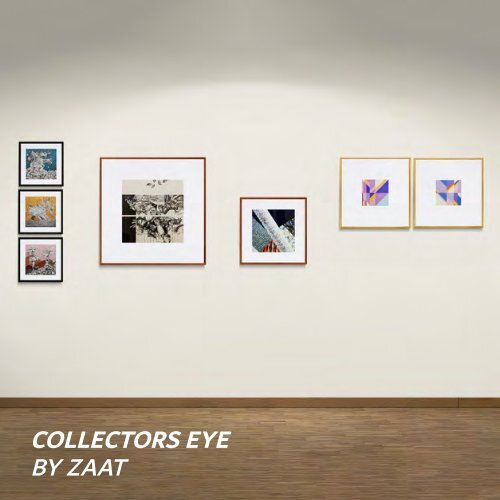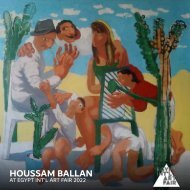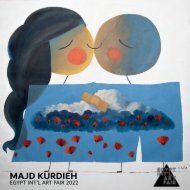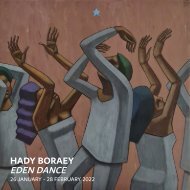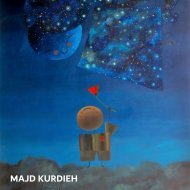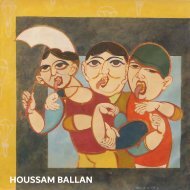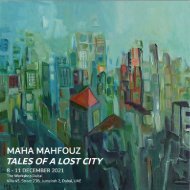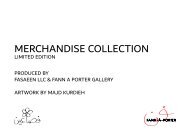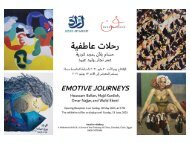e-Catalogue - Collectors Eye by ZAAT
You also want an ePaper? Increase the reach of your titles
YUMPU automatically turns print PDFs into web optimized ePapers that Google loves.
COLLECTORS EYE<br />
BY <strong>ZAAT</strong>
About The Exhibition<br />
Featuring modern masters to contemporary artists, this exhibition<br />
will present works <strong>by</strong> artists ARMAN, Kamal Boullata, Enaya Bukhary,<br />
Leonardo Cremonini, Dia Al Azzawi, Samia Hala<strong>by</strong>, Omar Khouri, Dr<br />
Suheir Osman, Juliana Seraphim, Dodi Tabbaa, Edouard Trémeau,<br />
Sabry Mansour and Zena Assi.<br />
Mostly renowned for their outstanding paintings, sculptures, and<br />
installations ; <strong>Collectors</strong> <strong>Eye</strong> puts focus on works on paper revealing<br />
new ideas, techniques and materials in a powerful display of creative<br />
experimentation and aims to provide a comprehensive selection of<br />
prints from the secondary market.<br />
About <strong>ZAAT</strong><br />
<strong>ZAAT</strong> is a multi-disciplinary platform created to promote and<br />
empower artists and designers. By offering a place for collectors to<br />
buy, sell and trade work that ranges in styles, movements and eras,<br />
<strong>ZAAT</strong> then reinvests into showcasing and supporting the production<br />
of contemporary work. Coming from the Arabic root meaning, one,<br />
essence, self, <strong>ZAAT</strong> upholds the integrity of the art and artists.<br />
Specializing in art from the Arab world, <strong>ZAAT</strong> is a digital platform that<br />
also curates events, advises clients interested in buying new work<br />
and consults on currently owned pieces. The platform is continually<br />
expanding with new artists and seeks out designers with social<br />
narratives and ethical production.<br />
Conceived as a place to connect art enthusiasts and artists together,<br />
<strong>ZAAT</strong> aims to make art more approachable and understandable while<br />
supporting artists.
ARMAN FERNANDES<br />
About The Artwork<br />
ARMAN was a French-born American artist known for his unique<br />
style of found-object sculpture and paintings. In his sculpture, he<br />
works with “accumulations” and destruction/ re-composition of<br />
objects while in his two dimensional pieces, he uses the imprints or<br />
traces of objects covered in ink to form the painting itself. The silk<br />
screen print “Violins and Brushes” is a classic example ARMAN’s<br />
work using his recurring image of the violin. It was created around<br />
the same time as his gigantic monument “Hope for Peace” at the<br />
Ministry of National Defense in Yarze, Lebanon.<br />
About The Artist<br />
In 1961, ARMAN (Armand Fernandez 1928 – 2005) was a founding<br />
member of the Nouveau Réalisme group along Jean Tinguely and<br />
Yves Klein. Later, he emigrated to the United States and lived and<br />
worked in New York until his death in 2005. His works are held in the<br />
collections of The Museum of Modern Art in New York, the National<br />
Gallery of Art in Washington, D.C., the Tate Gallery in London, and<br />
the Musée d’Art Moderne ed d’Art Contemporain in Nice, among<br />
others. Notably, Andy Warhol owned two of his works, and Arman<br />
appeared in the Warhol’s film “Dinner at Daley’s”.<br />
Arman Fernandes, Violins & Brushes, 1995, Serigraph 72/150, 75 x 55 cm
ZENA ASSI<br />
About The Artwork<br />
Drawing inspiration from her native Beirut, Zena Assi’s work portrays<br />
the socio-cultural aspects and intense emotions of contemporary<br />
urban society such as migration and memory. Inspired <strong>by</strong> Goya in<br />
both his depiction of the suffering and the medium of his work, Assi<br />
illustrates the corruption-made humanitarian crisis facing present<br />
day Lebanon. Her etchings with hand colored aquatint, entitled Ecce<br />
Homo, draw parallels with the past and the cyclical nature of history.<br />
About The Artist<br />
Born in Lebanon, Zena Assi (1974) graduated from l’Academie Libanaise<br />
des Beaux Arts (ALBA) and taught drawing and visual communication<br />
at different universities. Her work has been at auction at<br />
Christie’s, Sothe<strong>by</strong>’s, Bonhams and Phillips and is part of collections<br />
such as ALBA, Barjeel Art Foundation and Institut du Monde Arabe.<br />
appeared in the Warhol’s film “Dinner at Daley’s”.<br />
Zena Assi, From Beirut With Love, Ecco Homo Series, 2021, etchings hand colored with aquatint, 30 x 30 cm
Zena Assi, Superman, Ecco Homo Series, 2021, etchings hand colored with aquatint, 30 x 30 cm<br />
Zena Assi, Ras Al Balad, Ecco Homo Series, 2021, etchings hand colored with aquatint, 30 x 30 cm
Zena Assi, Mastercard, Ecco Homo Series, 2021, etchings hand colored with aquatint, 30 x 30 cm<br />
Zena Assi, The Amazon, Ecco Homo Series, 2021, etchings hand colored with aquatint, 30 x 30 cm
Zena Assi, Three Giants, Ecco Homo Series, 2021, etchings hand colored with aquatint, 30 x 30 cm
KAMAL BOULLATA<br />
About The Artwork<br />
Early in his career, Kamal Boullata developed a distinct style that<br />
embedded Arabic words and letters into colorful geometric designs<br />
that evoke his childhood in Jerusalem as well as his early training<br />
under the iconic painter Khalil Halabi. The lithograph above “Second<br />
Quartet, Opus3” displays a bright patterning commonly found in his<br />
work and is part of a series with another work in the collection “Third<br />
Quartet, Opus3”.<br />
About The Artist<br />
An artist and art historian, Kamal Boullata (Jerusalem, 1942) creates<br />
work in which the Palestinian identity and the conditions of exile<br />
form the basis of his artistic explorations.<br />
He graduated from the Academy of Rome and the Corcoran Art Museum<br />
School in Washington, DC. His works are found in both private<br />
and public collections, including the British Museum, London;<br />
the Museum of the Alhambra, Granada; Institut du Monde Arabe,<br />
Paris; New York Public Library, New York; Bibliothèque Louis Notari,<br />
Monaco; Zimmerli Art Museum, New Brunswick; and Jordan National<br />
Gallery of Fine Arts, Amman.<br />
Kamal Boullata, Second Quartet, Opus 3,<br />
1994, Lithograph VI/XXX, 26 x 26 cm<br />
Kamal Boullata, Third Quartet, Opus 3,<br />
1994, Lithograph VI/XXX, 26 x 26 cm
ENAYA BUKHARY<br />
About The Artwork<br />
Inspired <strong>by</strong> Islamic heritage with a nod to modernity, Enaya Bukhary’s<br />
silk screen print “Untitled” is almost monochromatically yellow with<br />
small touches of red. The geometric or cellular-like shapes and bold<br />
colors create a patterned composition that incorporates organic and<br />
botanical components poetically woven throughout the work.<br />
About The Artist<br />
Born in Damascus in 1960, Syrian artist Enaya Bukhary is a member<br />
in both the Union of Syrian Fine Artists and Friends of Art Association.<br />
Her work can be found in the Syrian Ministry of Culture, Qatar<br />
Museum of Fine Arts and private collections in France, Spain, Greece,<br />
US, Jordan, Iraq, Kuwait, Dubai, Vienna, Tunisia and Lebanon.<br />
Enaya Bukhary, Untitled, Edition 1/1, 1994, silk screen, 80 x 20 cm
LEONARDO CREMONINI<br />
About The Artwork<br />
Cremonini’s poetic summertime figures and landscapes appear both<br />
timeless and yet like a photo, taken at a distinct moment. The colors<br />
and brushstrokes blend the bodies and the landscape together<br />
and the unique light-filled compositions have a geometric quality to<br />
them. In this black and white work, the sunbather melts into her surroundings<br />
which were created with points and hash marks.<br />
About The Artist<br />
Born in Italy, Leonardo Cremonini (1925-2010) attended the Academy<br />
of Fine Arts in Bologna and began exhibiting his figurative<br />
works, gaining fame in the US and France. Many prominent cultural<br />
figures championed his work such as painter Francis Bacon, writers<br />
W. H. Auden, Umberto Eco and Italo Calvino as well as the Director<br />
of MoMa who described his canvases as having a “spirit of timeless<br />
monumentality.” Retrospectives of Cremonini’s work have been held<br />
in museums of Basel, Brussels, Metz, Paris, Prague, Siena, Strasbourg,<br />
Tokyo, Monte Carlo, Grenoble, and Milan.<br />
Leonardo Cremonini, Untitled, 1994, print/etching, 42 x 56 cm
DIA AL AZZAWI<br />
About The Artwork<br />
Recognized as one of the pioneers of modern Arab art, Dia al Azzawi<br />
(Baghdad, 1939), started his artistic career in 1964, after graduating<br />
from the Institute of Fine Arts in Baghdad. A socially and politically<br />
committed artist, his work is nourished <strong>by</strong> popular culture and folkloric<br />
mythologies, contemporary wars and the violence embedded in<br />
the history of Iraq. Halfway between fig¬u¬ra¬tive and abstract, his<br />
work is at the same time ref-er¬en¬tial and dec¬o¬ra¬tive, expres¬sive<br />
and open, as is seen in “From Akka (Palestine) death came to Tal<br />
el Zaatar” (Lebanon). This work is part of a series that memorializes<br />
a massacre of Palestinians that was published in “Illustrated poems<br />
for Tel el Zaatar” with text <strong>by</strong> Moroccan writer, Tahar Ben Jelloun.<br />
About The Artist<br />
Al-Azzawi played a foundational role in Iraqi art movements such as<br />
the New Vision Group (1969) and the One Dimension Group (1971).<br />
His work is found in international private and public collections including<br />
the Museum of Modern Art- Baghdad, Damascus and Tunis;<br />
Jordan National Gallery of Fine Arts, Amman; Mathaf: Arab Museum<br />
of Modern Art, Doha; Barjeel Art Foundation, Sharjah; Kinda Foundation,<br />
Saudi Arabia; Una Foundation, Casablanca; Arab Monetary<br />
Fund, Abu Dhabi; Development Fund, Kuwait; Jeddah International<br />
Airport; British Museum, London; Tate Modern, London; Victoria<br />
and Albert Museum, London; Institut du Monde Arabe, Paris; Bibliothèque<br />
Nationale de France, Paris; Colas Foundation, Paris; Harba<br />
Collection, Iraq and Italy; Gulbenkian Collection, Barcelona; and Library<br />
of Congress and the World Bank, Washington, DC.<br />
Dia Al Azzawi, From Akka Death Came to Tal el Zaatar, 1997, Lithograph 53/100, 62 x 62 cm
SAMIA HALABY<br />
About The Artwork<br />
Samia Hala<strong>by</strong> is inspired <strong>by</strong> the concept of abstraction - the notion<br />
of reality being represented through form, as well as the various art<br />
abstraction movements. In the silkscreen work “Position Delay”, the<br />
title alludes to a possible problem being solved or philosophical question<br />
that the artist is asking herself which is left to the interpretation<br />
of the viewer.<br />
About The Artist<br />
A forerunner of contemporary abstraction in the Arab world, Samia<br />
Hala<strong>by</strong> (Jerusalem, 1936) is a leading abstract painter and a prominent<br />
scholar. After receiving her Masters in Painting from Indiana<br />
University, she studied geometric abstraction in Islamic architecture<br />
around the Eastern Mediterranean.<br />
Hala<strong>by</strong> has been collected <strong>by</strong> international institutions including the<br />
Solomon R. Guggenheim Museum of Art (New York and Abu Dhabi);<br />
Yale University Art Gallery; National Gallery of Art, Washington D.C.;<br />
Art Institute of Chicago; Cleveland Museum of Art; Institut du Monde<br />
Arabe; and the British Museum. She was the first full-time female<br />
associate professor at the Yale School of Art and publishes academic<br />
articles about Palestinian art.<br />
Samia Hala<strong>by</strong>, Position Delay, 1981, Silkscreen print 43/75, 42 x 42 cm
SABRY MANSOUR<br />
About The Artwork<br />
After being trained in a classical style of painting, Sabry Mansour<br />
began his signature abstract and symbolic style with predominantly<br />
female figures, night landscapes and symbolic elements. In this print<br />
“Our Village at Night”, Mansour has depicted women in different positions<br />
inside their houses. Using shading to create the organically<br />
curvy figures and architecture against minimal backdrops, he creates<br />
a stylistically mystical and serene landscape, exuding a calmness and<br />
spiritually typical to his oeuvre. Another edition of this print can be<br />
found at the Modern Art Museum in Cairo.<br />
About The Artist<br />
Egyptian artist Sabry Mansour (1943) received his BA and MA in<br />
Fine Arts from Helwan University in Cairo. At the same university,<br />
he taught painting and was the Dean of the Faculty of Fine Arts for<br />
three years. He participated in numerous exhibitions, festivals and<br />
biennales both nationally and in Bulgaria, France, Russia, Spain, Germany,<br />
Italy, Kuwait, Tunisia and Mexico. Mansour has won many international<br />
awards and has publications on his work including recent<br />
retrospectives.<br />
Sabry Mansour, Our Village At Night, 1982, Serigraph, Ink on Paper, 49 x 59 cm
OMAR KHOURI<br />
About The Artwork<br />
Well-known for comic illustrations and portrait paintings, Omar<br />
Khouri’s work touches on the complicated and layered psychology of<br />
the individual in society.<br />
In his current print series, he uses illustration and printmaking to create<br />
a portrait of each city. Using his style of portrait fragmentation<br />
which is based on traditional Islamic geometry, the breaks or lines<br />
can be seen as a reflection of the contradictions and cracks of fragility<br />
in each place. In “Aleppo”, instead of featured monuments of the<br />
city, you see the destruction of the civil war. In “Jerusalem”, you see<br />
one of the iconic features of the city, the “Dome of the Rock.”<br />
About The Artist<br />
Lebanese artist Omar Khouri (1978) graduated from Massachusetts<br />
College of Art and Design, Boston and works primarily in painting,<br />
comics, and film. In 2006, he co-founded Samandal Comics and was<br />
the co-writer, concept artist, robot designer and actor in the award<br />
winning Lebanese Science Fiction film “The Last Days of the Man of<br />
Tomorrow.” Khouri’s work has been exhibited and is held in collections<br />
in the US, UK, Europe, Japan and Lebanon.<br />
Omar Khouri, Aleppo, 2020,<br />
silkscreen print limited edition of 25, signed and numbered <strong>by</strong> hand,<br />
40 x 60 cm<br />
Omar Khouri, Jerusalem, 2020,<br />
silkscreen print limited edition of 25, signed and numbered <strong>by</strong> hand,<br />
40 x 50 cm
DR SUHEIR OSMAN<br />
About The Artwork<br />
Using textile and printing techniques in her work, Suheir Osman is<br />
known for the art of Batik. This process, as seen in “Untitled”, starts<br />
with the ancient craft of cloth making, then proceeds to the batik the<br />
dyeing process where wax is used create places or shapes where the<br />
dye cannot reach. Afterwards, she creates a template that will print<br />
the geometric design. Inspired <strong>by</strong> ancient Egyptian, Coptic or Islamic<br />
civilizations, she creates contemporary motifs, repeating shapes<br />
through varied compositions, emulating ideas of the infinite or building<br />
on the past to reach the future.<br />
About The Artist<br />
Egyptian artist Suheir Osman (1952) received her PhD in applied<br />
arts and is a professor at Helwan University. Specializing in textiles,<br />
design and printing she has exhibited in Germany, Italy, Yugoslavia,<br />
Belgium, Romania, France, Sudan, Netherlands, India, Portugal, Chile,<br />
Spain, Oman, Kuwait, Austria, Cyprus, China, Japan and Iraq. She has<br />
published numerous academic texts for journals and conferences and<br />
has received over 30 local and international awards.<br />
Dr Suheir Osman, Untitled, 1993, Batik, 137 x 83 cm
JULIANA SERAPHIM<br />
About The Artwork<br />
Known for creating dream-like worlds, surreal imaginary and landscapes,<br />
Juliana Seraphim developed her own visual language that<br />
was inspired from memories in her childhood.<br />
In 1971, she was commissioned <strong>by</strong> Shorewood Publishers of New<br />
York to illustrate nine winners of the Nobel Prize for Literature on<br />
twenty-seven on copper plates. “Pour TS Elliot” is a rare Artist Proof<br />
of the limited edition whose imaginary and symbols could reference<br />
the Free Masons.<br />
About The Artist<br />
Juliana Seraphim (Jaffa,1934-2005) was among the first waves of<br />
Palestinian refugees to move to Lebanon in 1952. She worked in refugee<br />
relief while attending art classes and training with the painter<br />
Jean Khalifié.<br />
Seraphim was awarded scholarships to France, Italy and Spain and<br />
represented Lebanon in the Biennale of Paris, the Biennale of Alexandria<br />
and the Biennale of Sao Paulo. Her work has been shown internationally<br />
in institutions such as: Museum of the City of Viareggio,<br />
Italy; The “Musée du suréalisme”, Paris; The National Gallery, Amman;<br />
Sursock Museum, Beirut; Museum of the Arab World Institute,<br />
Paris; Barcaccia Art Gallery, Rome; Chenill’s Gallery, London 1967;<br />
Smithsonian Institution, Washington; Imperial Museum of Tokyo;<br />
and Belvedere Museum, Tunis.<br />
Juliana Seraphim, Pour TS Elliot, 1970, Ink on paper, 65 x 50 cm
DODI TABBAA<br />
About The Artwork<br />
Inspired <strong>by</strong> daily life and objects around her, Dodi Tabbaa’s paintings<br />
and monographs use color and line to illustrate her experiences and<br />
moods from excited to peaceful.<br />
During the time period of “Untitled,” Tabbaa was living in the countryside<br />
and creating complex compositions between representation<br />
and abstraction. The works have a harmony and opposition in colors<br />
that are printed or painted on Japanese handmade paper that adds<br />
texture and richness to the piece.<br />
About The Artist<br />
Amman-based Dodi Tabbaa (1952) was born in Pakistan and received<br />
her BFA in Fine Arts and Graphic Design in Lahore and a post-graduate<br />
diploma in printmaking, textile design, typography in the United<br />
Kingdom.<br />
Her work can be found in the public collections of Jordan National<br />
Gallery of Fine Arts, Amman; Bangladesh National Gallery Dhaka;<br />
French Cultural Centre Amman; Jordan Ministry of Culture & Youth<br />
Amman; Arab Bank Amman; Al Mansourieh Foundation Saudi Arabia<br />
and in private collections in Dubai, Australia, Saudi Arabia, Japan,<br />
Thailand, Jordan, Finland, Bahrain, Norway, U.K., USA, France, Switzerland,<br />
Holland, Spain, Indonesia, Cyprus, Pakistan, Brazil, Italy, Portugal,<br />
Canada, Bangladesh, Malaysia, Russia.<br />
Dodi Tabbaa, Untitled, 1994, Hand colored etching, 38x28 cm / 60x45 cm
EDOUARD TRÉMEAU<br />
About The Artwork<br />
Classically trained Édouard Trémeau’s work is masterfully executed<br />
using dramatic lights and shadows with faces turned away and covered<br />
in darkness. He took part in various collectives that denounced<br />
forms of political oppression and inequalities, traces of which can<br />
be found in his work that exudes anguish, solitude, confinement and<br />
ruin. In this work, the print is akin to a diptych with a man turned<br />
away coupled with the touristic depiction of Baalbeck, Lebanon. The<br />
editioned print is titled “Sur la passe: la paix” (On the pass: peace)<br />
while in a retrospective exhibition publication “Edouard Trémeau.<br />
Works 1967-2002” he titles the same edition: “Liban: paix retrouvee”<br />
(Lebanon: Peace Found).<br />
About The Artist<br />
Born in France in 1936, Édouard Trémeau studied at the School of<br />
Applied Arts, École Nationale Supérieure des Beaux-Arts de Paris<br />
and École Normale Supérieure de Cachan. His work is in public collections<br />
such as LAM (Musée d’Art Moderne du Nord); Villeneuve<br />
d’Ascq, Musée de l’Hospice Comtesse, Lille; Fonds National d’Art<br />
Contemporain, Lille; and the Sursock Museum, Beirut.<br />
Edouard Trémeau, Sur le Passé: La paix, 1994, Print ed 49/80
About Fann A Porter®<br />
Fann A Porter is a contemporary art gallery that represents a diverse selection of emerging<br />
international and regional artists, with locations in Dubai, UAE and Amman, Jordan. The<br />
gallery aims to nurture the burgeoning and dynamic contemporary art scene through quality<br />
exhibitions, non-profit events, auctions, and an active community program.<br />
The gallery’s exhibition program includes ten curated exhibitions a year, and features artists<br />
working across diverse media. Fann A Porter has established a series of dialogues and<br />
collaborations with curators, writers, museums, governmental entities, and institutions to<br />
affirm its commitment to support the long-term development of young contemporary artists<br />
from the Middle East.<br />
In 2015, the gallery organized a charity auction Artists for the Kids of Syria under the<br />
patronage of His Highness Sheikh Nahyan Bin Mubarak Al Nahyan, UAE Minister of Culture<br />
and in collaboration with the UAE Red Crescent. The charity auction helped raise over AED<br />
500,000 to help the children in the refugee camps in Jordan. In 2019, the gallery launched Art<br />
for All Collective (AFA) to provide a platform to make quality art accessible through bespoke<br />
payment plans, a first of its kind initiative for the Middle East.<br />
By hosting a regular public programming including exhibitions, talks, non-profit initiatives,<br />
and <strong>by</strong> participating in fairs, Fann A Porter has established itself in forefront of the region’s<br />
exciting arts landscape.<br />
Founded in 2009 <strong>by</strong> collector Ghada Kunash, the gallery was initially known as Vindemia.art,<br />
opened adjacent to and under the umbrella of Vindemia, an antiques and collectibles gallery<br />
at Jumeirah Beach Residence, Dubai. In 2010, the gallery partnered with Kempinski Hotel Mall<br />
of The Emirates, for a dedicated space for the art. In 2014, under the same trade license of<br />
Vindemia Novelties LLC, the art gallery was rebranded to Fann A Porter.<br />
In 2016, Ghada Kunash opened The Workshop Dubai, combining her two ventures – Vindemia<br />
and Fann A Porter, a unique community space consisting of a café and design space, providing<br />
visitors with a unique artistic and cultural experience. The Workshop Dubai, with its naturally<br />
bathed garden, is located in the heart of Jumeirah.<br />
In 2020, with the vision to expand and provide a local platform, Ghada Kunash opened a<br />
second Fann A Porter outpost, in Amman, located at Manara Arts & Culture, a creative hub<br />
and social space in the heart of Jabal Al Lweibdeh.<br />
Dubai Head Office<br />
Villa 45, Street 23B, Jumeirah 2, Dubai, United Arab Emirates<br />
fann@theworkshopdubai.com<br />
+971 4 341 2595<br />
P.O. Box 215457 Dubai, United Arab Emirates<br />
www.fannaporter.com<br />
Amman Branch<br />
Manara Arts and Culture, Dirar Ben Al-Azwar, St. 56, Amman, Jordan<br />
amman@fannaporter.com<br />
+962 79 716 7022<br />
FannAPorter


